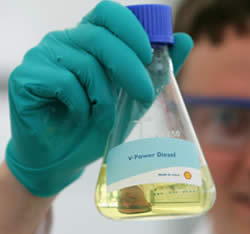Difference between Diesel and Kerosene
Key Difference: Diesel is a liquid fuel that is used in diesel engines. It is commonly derived from crude oil. Petroleum diesel or petrodiesel is produced by distilling crude oil between 200 °C (392 °F) and 350 °C (662 °F) at atmospheric pressure. Kerosene is a combustible hydrocarbon liquid that is used as fuel in older lamps and heating units. Kerosene is in the C12 to C15 hydrocarbon range. It is made using these chains.
 The process of creating diesel includes drilling for crude oil. The oil drilled from the ground is then sent to a refiner. At the refinery, heat is used to separate out different products at boiling points. The oil is then sent through a distillation process where it is applied with heat and pressure causing a chemical reaction. The application of heat and pressure determines if the product becomes petrol or diesel. Following distillation, the fuel is blended with additives that help improve the quality of the fuel. The crude oil is composed of various hydrocarbons that differ in composition. These different hydrocarbons are what make the different products that are derived from the oil. Simple hydrocarbons such as CH4, C2H6, C3H8, and C4H10 are light gases and are used in solvents for paints. The other longer chains of hydrocarbons are used to create fuel.
The process of creating diesel includes drilling for crude oil. The oil drilled from the ground is then sent to a refiner. At the refinery, heat is used to separate out different products at boiling points. The oil is then sent through a distillation process where it is applied with heat and pressure causing a chemical reaction. The application of heat and pressure determines if the product becomes petrol or diesel. Following distillation, the fuel is blended with additives that help improve the quality of the fuel. The crude oil is composed of various hydrocarbons that differ in composition. These different hydrocarbons are what make the different products that are derived from the oil. Simple hydrocarbons such as CH4, C2H6, C3H8, and C4H10 are light gases and are used in solvents for paints. The other longer chains of hydrocarbons are used to create fuel.
Diesel is a liquid fuel that is used in diesel engines. It is commonly derived from crude oil, but there are also alternatives that are not derived from distilling petroleum fuel oil; these are known as biodiesel, biomass to liquid (BTL) diesel and gas to liquid (GTL) diesel. The name of the fuel is derived from the name of German inventor Rudolf Diesel who created the compression-ignition engine. Petroleum diesel or petrodiesel is produced by distilling crude oil between 200 °C (392 °F) and 350 °C (662 °F) at atmospheric pressure. Diesel has a mix of carbon chains between 8 and 21 carbon atoms per molecule. Diesel fuel quality is measured by its Cetane number. A higher cetane number indicates that the fuel ignites more readily when sprayed into hot compressed air. Diesel has a disadvantage in the winter as a vehicle fuel because of its viscosity (ability to flow). The viscosity of diesel increases as the temperature decreases and the fuel requires a special fuel pump for pumping the fuel.
Diesel has approximately 34.6 MJ/liter of energy content and produces 2.65 kg of CO2 per kilo of diesel used. It has a calorific value of 45.5 MJ/kg (megajoules per kilogram) and has a boiling range of 250°C to 350°C. Diesel is a popular alternative to petrol because of its ability to provide a better fuel economy and has less CO2 emissions. Diesel is a popular source of fuel and is believed to be better for cars that have a high consumption. It is also significant cheaper compared to petrol and provides more torque at low speeds.

Kerosene is a combustible hydrocarbon liquid that is used as fuel in older lamps and heating units. When oil is refined and heated, the different types of hydrocarbons are broken down. Many products can be derived from crude oil by linking and unlinking hydrocarbons. Kerosene is in the C12 to C15 hydrocarbon range. It is made using these chains. The term ‘kerosene’ is derived from Greek ‘keros’ meaning “wax.” The word Kerosene was originally registered as a trademark by Abraham Gesner in 1854 and only the North American Gas Light Company and the Downer Company were allowed to call their lamps run on Kerosene fuel, Kerosene. It later evolved into a genericized trademark.
Kerosene is a thin, clear liquid that is created from hydrocarbons and has a density of 0.78–0.81 g/cm3. However, it is dyed in many countries to blue to differentiate if from water. It is derived by fractional distillation of petroleum between 150 °C and 275 °C. Kerosene has approximately between 6 and 16 carbon atoms per molecule. Kerosene is 70% composed of branched and straight chain paraffins and naphthenes (cycloparaffins) and also has aromatic hydrocarbons and olefins. Kerosene has a vaporizing point in between 37 and 65 °C (100 and 150 °F) and has a autoignition temperature of 220 °C (428 °F). Kerosene cannot be mixed in water but can be mixed with petroleum solvents.
Image Courtesy: howstuffworks.com, supercheapauto.com.au









Comments
cartier love br...
Wed, 11/01/2017 - 03:25
Add new comment